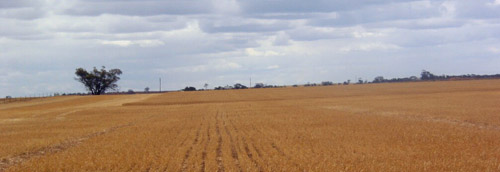TOPCROP4
Location: Tarranyurk
Australian Soil Classification: Endohypersodic, Pedal, Hypercalcic CALCAROSOL
General Landscape Description: Gently undulating plain.
Site Description: Cropping Paddock.
Geology: Quaternary deposits (Woorinen Formation).
Native Vegetation: Mallee and Yellow Gum.

| TOPCROP4 Landscape. |
Soil Profile Morphology:
Surface Soil
| Ap | 0-12 cm | Very dark greyish brown (10YR3/2); soft surface condition; clay loam (sandy); weak coarse to medium blocky structure; firm consistence dry; moderately calcareous; pH 8.2; abrupt change to: |
 TOPCROP4 Profile |
| Subsoil | |||
| B21 | 12-40 cm | Strong brown (7.5YR5/6); light clay; moderate structure; earthy fabric; firm consistence dry; few (5-10%) soft calcareous segregations; very highly calcareous; very many macropores; pH 8.4; clear change to: | |
| B22k | 40-70 cm | Reddish yellow (7.5YR7/6); light clay; weakly structured; very firm consistence dry; soft calcareous segregations common (20%); very highly calcareous; pH 9.1; gradual change to: | |
| B23 | 70-100 cm | Reddish yellow (5YR6/6); medium heavy clay; medium very coarse prismatic, parting to strong fine blocky structure; strong consistence dry; soft calcareous segregations (15%) common; very highly calcareous; pH 9.6; gradual change to: | |
| B24 | 100-130 cm | Reddish yellow (5YR6/6) with light yellowish brown (10YR6/4) mottles; medium heavy clay; moderate very coarse prismatic, parting to strong fine blocky structure; strong consistence dry; few (5%) soft calcareous segregations and manganese flecks; very highly calcareous; pH 9.7. | |
Key Profile Features:
- Gradual increase in texture (clay content) with depth down the soil profile.
- Fine earth carbonates common in deeper subsoil.
Soil Profile Characteristics:
pH | Salinity Rating | |||
Surface (A1 horizon) | Moderately Alkaline | Low-Moderate | Non-Sodic | None |
Subsoil (B21 horizon) | Moderately Alkaline | Moderate | Non-Sodic | None |
Deeper Subsoil (at 70-100 cm) | Extremely Alkaline | Low-Moderate | Strongly Sodic | None1 |

| The surface is moderately alkaline. The subsoil is moderately alkaline becoming extremely alkaline with depth. | The profile has a low to moderate salinity rating throughout. | The surface is non sodic. The upper subsoil is non sodic becoming strongly sodic with depth. | Boron levels are quite low throughout the profile. | Clay content increases with depth. |
Chemical and Physical Analysis:
Horizon | Horizon Depth (cm) | pH (water) | pH (CaCl2) | EC dS/m | NaCl % | Organic Carbon % | Nitrogen % | Boron mg/kg | Exchangeable Cations | Field Capacity pF2.5 | Wilting Point pF4.2 | Coarse Sand (0.2-2.0mm) | Fine Sand (0.02-0.2mm) | Silt (0.002-0.02mm) | Clay (<0.002mm) | |||
Ca | Mg | K | Na | |||||||||||||||
Meq/100g | ||||||||||||||||||
Ap | 0-12 | 8.2 | 7.8 | 0.35 | <0.01 | 1.8 | 0.12 | 2.0 | 20 | 2.5 | 1.9 | 0.2 | 30.5 | 13.2 | 30 | 24 | 11 | 27 |
B21 | 12-40 | 8.4 | 8.0 | 0.45 | 0.01 | 1.8 | 17 | 4.2 | 1.3 | 0.2 | 32.5 | 14.2 | 27 | 21 | 8 | 26 | ||
B22 | 40-70 | 9.1 | 8.4 | 0.19 | - | 4.2 | 23 | 12 | 1.1 | 0.76 | 41.1 | 16.6 | 21 | 14 | 4 | 27 | ||
B23 | 70-100 | 9.6 | 8.8 | 0.51 | 0.01 | 2.7 | 16 | 1.6 | 5 | 45.2 | 21.4 | 17 | 16 | 5 | 41 | |||
B24 | 100-130 | 9.7 | 9.0 | 0.67 | 0.03 | 2.6 | 14 | 1.5 | 7.5 | |||||||||
Management Considerations:
- In general, management strategies for all soils should aim to increase organic matter levels in the surface soil; minimise the degradation of soil aggregates and porosity; promote the development of stable biopores; improve the calcium status of the ion exchange complex (particularly when sodium is a significant part), and break up any hardpans. Less frequent tillage; using less aggressive implements, and working the soil at optimum moisture conditions can all assist in maintaining soil aggregation and porosity as well as reducing the breakdown of organic matter.
- The deeper subsoil becomes very strongly to extremely alkaline (from 40 cm depth). This indicates that phosphorus and some trace elements such as iron, manganese, zinc and copper may be poorly available to plants and deficiencies may occur. Deficiencies can be determined by plant tissue analysis.
- The upper subsoil is non-sodic (and non-dispersive). Root and water movement in the upper subsoil is not likely to be restricted as for Sodosols in the region. The deeper subsoil (from 70 cm depth) though becomes strongly sodic (and dispersive) which will restrict root and water movement at depth.


